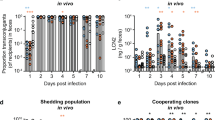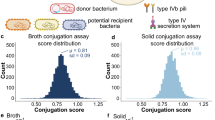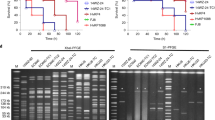Abstract
TRANSFER of virulence from a pathogenic to a non-pathogenic strain of Agrobacterium has been reported to occur in vivo1,2 and is due to the transfer of a plasmid which codes for virulence3,4. In the experimental conditions described, virulence transfer can be detected only after several weeks. The reason for this delay is not clear. The most likely explanations are (1) that infrequent transfer occurs long before it can be detected, detection being dependent on a subsequent increase in the ratio of converted to unconverted recipients or (2) that conditions suitable for virulence transfer occur only after donor and recipient have been in contact for several weeks. The main difficulty in distinguishing between these two alternatives is technical. When pathogenicity testing is used to detect virulence transfer, low frequency transfer is impossible to detect unless thousands of inoculations are made at each assessment. It is known, however, that the virulence plasmid codes for characters other than virulence5–7. One of these is utilisation of octopine and, as Kerr8 has pointed out, this could be used instead of pathogenicity testing to detect plasmid transfer. This communication describes both in vivo and in vitro transfer of virulence using octopine utilisation to detect plasmid transfer.
This is a preview of subscription content, access via your institution
Access options
Subscribe to this journal
Receive 51 print issues and online access
$199.00 per year
only $3.90 per issue
Buy this article
- Purchase on Springer Link
- Instant access to full article PDF
Prices may be subject to local taxes which are calculated during checkout
Similar content being viewed by others
References
Kerr, A., Nature, 233, 1175–1176 (1969).
Kerr, A., Physiol. Pl. Pathol., 1, 241–246 (1971).
Van Larebeke, N., et al., Nature, 255, 742–743 (1975).
Watson, B., Currier, T. C., Gordon, M. P., Chilton, M. D., and Nester, E. W., J. Bact., 123, 255–264 (1975).
Bomhoff, G. H., et al., Molec. gen. Genet., 145, 177–181 (1976).
Chilton, M. D., Farrand, S. K., Levin, R., and Nester, E. W. Genetics, 83, 609–618 (1976).
Kerr, A., and Roberts, W. P., Physiol. Pl. Path., 9, 205–211 (1976).
Kerr, A., J. theor. Biol., 51, 409–417 (1975).
Petit, A., and Tempe, J., C.r. Acad. Sci. Paris, D 275, 137–139 (1975).
Keane, P. J., Kerr, A., and New, P. B., Aust. J. biol. Sci., 23, 585–595 (1970).
Genetello, C., et al., Nature, 265, 561–563 (1977).
Author information
Authors and Affiliations
Rights and permissions
About this article
Cite this article
KERR, A., MANIGAULT, P. & TEMPÉ, J. Transfer of virulence in vivo and in vitro in Agrobacterium. Nature 265, 560–561 (1977). https://doi.org/10.1038/265560a0
Received:
Accepted:
Issue Date:
DOI: https://doi.org/10.1038/265560a0
This article is cited by
-
Isolation of Agrobacterium tumefaciens/ biovar 1 from the crown gall of Cerasus humilis in China
Journal of Plant Pathology (2022)
-
Genetic diversity of tumorigenic bacteria associated with crown gall disease of raspberry in Serbia
European Journal of Plant Pathology (2015)
-
Phylogenetic relationship and genetic diversity of Agrobacterium spp. isolated in Poland based on gyrB gene sequence analysis and RAPD
European Journal of Plant Pathology (2012)
-
A Highly Selectable and Highly Transferable Ti Plasmid to Study Conjugal Host Range and Ti Plasmid Dissemination in Complex Ecosystems
Microbial Ecology (2004)
-
A risk assessment study of plant genetic transformation usingAgrobacterium and implications for analysis of transgenic plants
Plant Cell, Tissue and Organ Culture (1997)
Comments
By submitting a comment you agree to abide by our Terms and Community Guidelines. If you find something abusive or that does not comply with our terms or guidelines please flag it as inappropriate.



